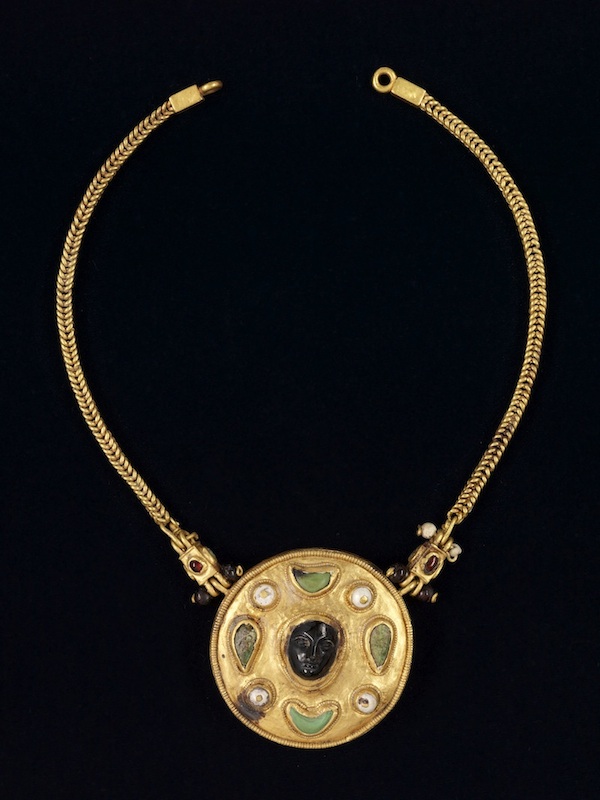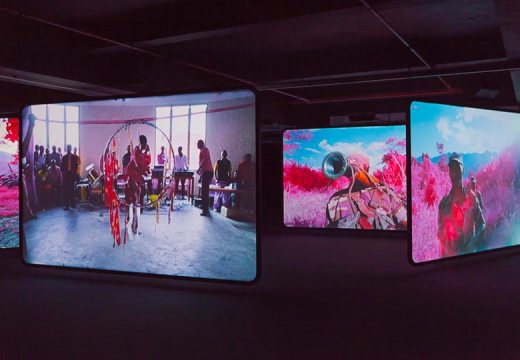‘Roads of Arabia: Archaeology and History of the Kingdom of Saudi Arabia‘ opens this week at the Nelson-Atkins Museum of Art in Kansas City. The exhibition examines the impact of ancient trade routes on the cultural history of the Arabian Peninsula. We spoke to Kimberly Masteller, the Jeanne McCray Beals Curator of South and Southeast Asian Art at the museum, and a co-curator of the exhibition, to find out more:
Click here for a gallery of highlights from the exhibition
Can you tell us a bit about the exhibition?
‘Roads of Arabia’ presents new archaeological discoveries from Saudi Arabia. The objects range in date from pre-historic to the present, and include colossal figurative sculptures and funerary stele, intricate metalwork, and elegant calligraphies. Arabia was a crossroads of trade in the ancient world and a sacred centre since the coming of Islam. For these reasons, Arabia gave birth to civilisations and also became a host to diverse peoples and cultural influences. One can trace the lives of these people through these artefacts.
What makes this a distinctive show?
Its newness. It is not often as a curator or museum visitor that you walk into an exhibition and are struck by objects that seem so completely new, so unknown. That is the power of many of the works in ‘Roads of Arabia’ such as the Neolithic stele. Yet, other works seem familiar. As you stroll through the galleries, there are echoes of Mesopotamia, Egypt and Rome.
The surprise lies not in their form, but in their location – that these art forms and cultural practices were alive in Arabia. These works are evidence of the interconnectedness of the ancient world. This is not what we all learned growing up from our history books. The evidence presented in this exhibition is revolutionary, it changes the way we think about the ancient history.
And then there is the Islamic material. The exhibition includes the gilded silver doors that the Ottomans created for the Ka’ba, nearly 400 years ago. You can see the evidence of centuries of pilgrims touching its surface. It is an incredibly powerful object.
How did you come to curate this exhibition?
I am a curator of South, Southeast Asian and Islamic art at the Nelson-Atkins. I have been following this exhibition since it opened in Paris in 2010 and was thrilled when the Nelson-Atkins entered into discussions with the Smithsonian about becoming a venue for the show. This is a big show with many important messages to convey. I am a co-curator, working with our esteemed curator of Ancient Art, Robert Cohon, and a great team of designers and educators to present the show.

‘Necklace with a Cameo Face Pendant’ (1st century C.E), Thaj, Tell al-Zayer, Saudi Arabia National Museum, Riyadh, 2059
What is likely to be the highlight of the exhibition?
I have many favourite objects in the exhibition. I would certainly put the Ka’ba doors at the top of my list. However, we have just finished installing the three colossal male sculptures from the Lihyanite Kingdom in a grand gallery space underneath one of the glass lenses of the new Bloch Building wing. These works are bathed in sunlight and stand before a wall mural depicting the valley of Al-Ula, where they once stood in temples in front of the royal tombs excavated into the cliff side. Visitors will be able to take in this vista while resting and looking at catalogues and books on Arabia, in a special oasis-themed seating area.
And what’s been the most exciting personal discovery for you?
For me, the most exciting discoveries were made while we were uncrating the objects and installing them. The surfaces of these objects are amazing. Many of the works are stone and bear evidence of their carving and subsequent life exposed in the desert or in the ground. The colossal figures were at least partially coated with plaster, bitumen and polychrome. The Saudi archaeologists have left these surfaces intact so each tells stories that are centuries old.
What’s the greatest challenge you’ve faced in preparing this exhibition?
The greatest challenge of this show is its size. The American Tour of Roads of Arabia contains around 200 objects, but there is a vast difference between exhibitions of 200 photographs or small paintings and a show like ‘Roads’ with 200 objects, many of which are large stone sculptures and stele. During installation, we spent most of the first two days installing four sculptures!
How are you using the gallery space? What challenges will the hang/installation pose?
We are installing the show in the exhibition galleries of the new Bloch Building, which wind around the south end of the building and afford opportunities for daylight under vaulted ceilings. The shape of these galleries is more narrow. The space works best when used in a progressive manner, to allow the exhibition to unfold as you move through it. In Houston, ‘Roads of Arabia’ was shown differently, in a large space with no walls, which created long vistas.
Our designer, John Jackson, has incorporated some walls, including a dividing wall with a horseshoe arch to create a symbolic division between the ancient and Islamic sections. These walls help to create a sense of mystery and containment around some works and a sense of surprise as you move through the sections. We have also used a transparent scrim to divide a group of historic tombstones from the al-Ma’la Cemetery in Mecca from the room with the Ka’ba doors. The scrim is printed with a faint geometric pattern that can be read like an architectural screen, however the pattern appears and disappears depending on how you look at it.
Which other works would you have liked to have included?
We had added an additional case called ‘Finding Mecca’ containing astrolabes, qibla nama and an Islamic world map to the section on Mecca and the pilgrimage roads. These objects are being lent by the Adler Planetarium in Chicago and a private collector.
We are also adding a series of interactive stations, including an archaeology station where visitors can re-assemble a facsimile of a ceramic artefact; a section focusing on incense and its value, including a smell station; an ancient language listening station; and a write your name in Arabic station. Along with our installation plan, these interpretive stations will create a very unique experience for visitors.
‘Roads of Arabia: Archeology and History of the Kingdom of Saudi Arabia’ is at the Nelson-Atkins Museum of Art, Kansas City from 25 April–6 July 2014.














![Masterpiece [Re]discovery 2022. Photo: Ben Fisher Photography, courtesy of Masterpiece London](http://zephr.apollo-magazine.com/wp-content/uploads/2022/07/MPL2022_4263.jpg)
‘Like landscape, his objects seem to breathe’: Gordon Baldwin (1932–2025)